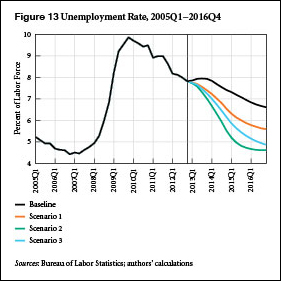How Much Fiscal Stimulus Do We Need?
How much fiscal stimulus would the government need to inject into the economy over the next two years in order to get the unemployment rate into the 5.5–5.9 percent range? In their newest strategic analysis, Dimitri Papadimitriou, Greg Hannsgen, and Michalis Nikiforos provide us with some harrowing answers.
The authors lay out a scenario (“scenario 3” in the analysis) featuring some favorable macroeconomic tailwinds in the form of higher private sector borrowing and increased exports. As they explain, such developments are not entirely unlikely (and policy changes could help contribute to such an export boost). Nevertheless, even in these relatively rosy circumstances the government would need to pitch in a spending increase of 6.8 percent* (after inflation) in each of 2013 and 2014 to bring the unemployment rate below 6 percent by the end of 2014. That would amount to a stimulus program worth around $600 billion over the next two years. Without these tailwinds from private sector borrowing and exports (“scenario 2”), spending would need to increase by 11 percent per year — or roughly over a trillion dollars of stimulus over two years — in order to bring unemployment down to around 5.5 percent.
As the authors note, Washington is not in the mood for a trillion-plus-dollar stimulus program, or a program half that size. Congress has consistently rejected a mere $50 billion for infrastructure repair. If anything, the policy challenge of the moment is to temper the zeal for cutting spending. Moreover, 5.5 percent unemployment is arguably still shy of what we ought to consider “good enough.” This level is around a full percentage point above where we were before the recession hit in 2007. In other words, even if this Congress were to approve a stimulus package larger than the 2009 Recovery Act (ARRA) — which is unimaginable at this point — we would still not be back to pre-recession unemployment levels after two years (or even four years, as the strategic analysis demonstrates).
While we’ve been focused on phantom budget menaces derived from assumptions about the state of medical technology in 2080, the jobs crisis has continued to ruin real lives. Without a dramatic turnaround in our fiscal priorities, it will continue to do so for years to come. It’s become pretty clear that the actual needs of this economy far outstrip what the political system is willing to deliver. (The authors actually favor direct job creation, in the form of an employer-of-last-resort policy, but they suggest that this is currently even further outside the realm of the politically possible as compared to traditional fiscal stimulus.)
Assuming no further stimulus is possible, the “best case” scenario over the next four years might be to merely hold off any new attempts at grand bargains or further budget cuts; to maintain the miserable status quo on the budget. In that case, as the figure below illustrates (the authors’ “Baseline” forecast represented by the black line), unemployment would still be above 7 percent in two years, and above 6.5 percent by the end of President Obama’s term in office (which, as the authors point out, is still in excess of the threshold at which the Fed would consider tightening monetary policy).
The full analysis can be downloaded here.
* Specifically, the increase applies to “real government purchases of final goods and government transfers to the private sector.”




 ShareThis
ShareThis
Sure would be nice if the Fed understood that tight monetary policy is when they lower interest rates, not when they raise them.
President Obama does not care about poverty. If he did, he would present a middle class tax relief proposal to Congress and use the bully pulpit to denounce members planning to vote against it.